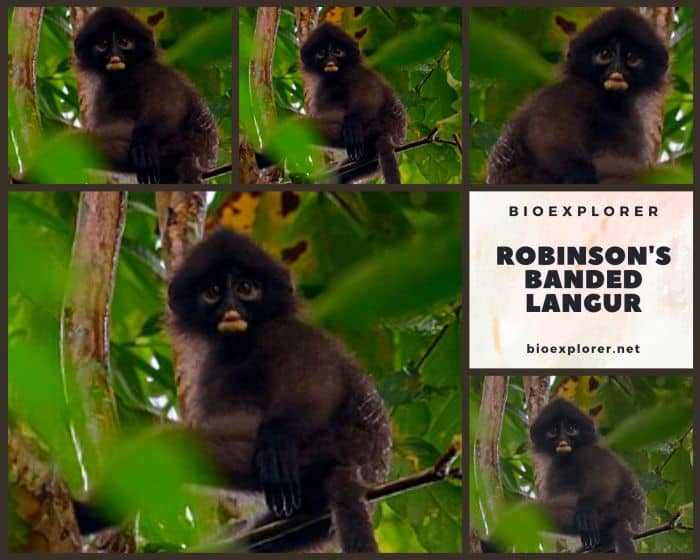


- Common Names: Robinson’s Banded Langur, Robinson’s Banded Surili
- Taxonomy Classification Year: 1910
- Monkey Size: 43 to 61 cm (17 to 24 in)
- Skin Color(s): Black
- Habitat: Rainforest
- Diet: Frugivorous
- Native Countries: Malaysia, Myanmar, Thailand
Robinson’s banded langur Distribution
Robinson’s Banded Langur Characteristics

Robinson’s banded langur[1] (Presbytis robinsoni), also known as Robinson’s banded surili, is a monkey species in the Cercopithecidae family.
- It was previously thought to be a subspecies of Raffles’s banded langur, Presbytis femoralis; genetic analysis has revealed that it is no more closely related to Raffles’s banded langur than it is to several other Presbytis species.
- The Robinson Banded Langur is similar to the Raffles Banded Langur, but the former has distinctive bare skin on the upper and lower lips and more prominent white circles under the eyes, comparable to the Dusky langur!
- The adult’s coat is black with white fur on the belly and a white stripe running down the underside of its limbs.
- Slender limbs perfectly adapted to arboreal life and a long tail protruding from the banded surili’s slender body.
- The hair on the head usually stands on end in a triangular or Mohican lock.
Robinson’s Banded Langur Facts
- Robinson Banded Langurs are generally shy and alert creatures, rarely leaving the comfort of the canopy.
- The species lives in groups of at least 3 but not more than 20 individuals, with an average group size of around 11.
- Robinson Banded Langur emits a distinctive alarm call when they sense danger. Researchers have compared its sound to the crackle of a machine gun.
- Like most diurnal primates, they are most active in the early morning and late afternoon. They are almost exclusively tree dwellers, so look them up.
- As leaf monkeys, they have large, multi-chambered stomachs and microflora that aid in digestion (characteristic of colobine primates). In addition, babies are born white with a black cross on their back (characteristic of presbyopia).
Suggested Reading: Types of Monkeys In The World
Cite This Page
APA7MLA8Chicago
BioExplorer.net. (2025, December 29). Robinson’s Banded Langur. Bio Explorer. https://www.bioexplorer.net/animals/mammals/monkeys/robinsons-banded-langur/.
BioExplorer.net. "Robinson’s Banded Langur" Bio Explorer, 29 December 2025, https://www.bioexplorer.net/animals/mammals/monkeys/robinsons-banded-langur/.
BioExplorer.net. "Robinson’s Banded Langur" Bio Explorer, December 29 2025. https://www.bioexplorer.net/animals/mammals/monkeys/robinsons-banded-langur/.











